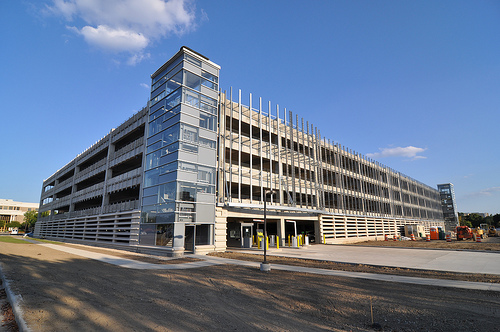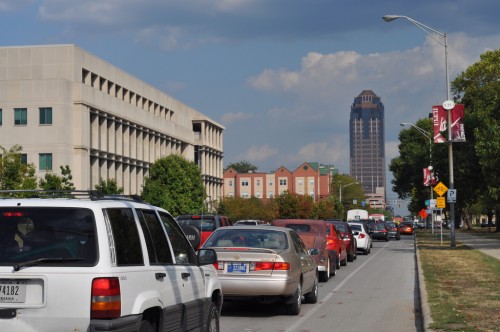
A couple of weeks ago, the IBJ reported that Indiana University is looking into a long term lease for its parking spaces on the main campus in Bloomington as well as its Indianapolis IUPUI campus. The column indicates that a request for proposal will be offered.
On the surface, it seems like an initiative that could yield significant dollars to the bottom line for Indiana University while removing the overhead of operating existing and planned parking facilities. Additionally, and as the IBJ article points out, higher parking rates could make using public transit more attractive, especially for IUPUI which hosts a large commuter student body. Currently, both Bloomington and Indianapolis campuses operate dedicated transit services for shuttling students to and from far flung lots or student housing.
However, a recent post regarding a similar deal at Ohio State University made it’s way to my email. The post states the following,
“Under the new contract, any action the university takes that could reduce the demand for parking spaces would constitute a “compensation event†that requires them to compensate the parking company for their lost revenue.”
The post implies that any transit related services that the university partakes in could be construed as reducing demand and result in potential compensation to said private bidder. The ramifications of such a clause are damning in their intent when viewed through the lens of an active transportation advocate. Would future student body growth be tied to proportional gains in automobile usage by students?

Furthermore, how can we hope to reduce the daily traffic jams generated by IUPUI’s 30k student body, again largely commuter based, if a 30 to 50 year plan is based upon current traffic models? One could make the case that if IUPUI chose not to improve current shuttle offerings or fund further improvements they could rely instead upon city or regional based transit efforts; those could conceivably still progress without penalty to the university.
With a deal not yet complete, all current talk is simply hyperbole. However, as an active transportation advocate, it pains me greatly to think that our publicly funded educational institutes could be hedging their bottom line on parking. It is my fear that a long term lease would hamstring the university into advocating for current or increased usage of parking to stave off “compensation events” such as those OSU may face. Moreover, subjecting an urban campus to 30 years of automobile based policy is quite simply, poor taste. While the optimist in me hopes that urban friendly policy wins out, the pessimist in me fears that the architects of this deal have dollar signs on their radar instead.
Ahhh this reminds me of something…
http://www.urbanophile.com/2010/09/07/indys-son-of-chicago-parking-meter-lease-to-be-a-disaster-for-city/
IUPUI used to provide a free annual IndyGo pass to students, then discontinued it in favor of a discounted self-paid monthly pass: http://www.iupui.edu/~fees/spass.html
Meanwhile, they charge all students fees for building more and more garages. Not sustainable in the least.
It wasn’t just a free IndyGo pass, but the “Red Line” route which ran around IUPUI and the hospitals and went a bit into downtown was free to use for anyone working at IU/Wishard/Riley or working/schooling at IUPUI.
I’d like to point out that IUPUI has 30k students, but that figure counts everyone. That counts people who are taking 1-2 classes, certification degrees, people taking online courses, etc… It is not common for 30k of cars to actually be on campus all at once. The traffic around IUPUI at 8:30am and 4:30pm is really no better or worse than any other section of downtown with a lot of workers all leaving at the same time.
I can only see this working out badly for IUPUI. They make money hand over fist on parking right now, especailly with all the tickets they write. And I have a big problem with handing it over to a for-profit company because this is designed as a service to be administered, not as a for-profit business venture. Turning it into a for-profit venture will only lead to a huge hike in fees, ticket writing, and will likely make it harder to do stuff like put more IndyGo bus stops within the IUPUI area.
Just a note: It’s a little known fact that the 30k enrollment number also includes the Columbus, IN campus.
I loved that pass.
I personally have witnessed more students driving now that the pass was discountinued. In some cases I knew some students that would use it as a park and ride. They would drive to campus on weekends and park their car and use the bus.
There are so many things not to like about this potential deal. First, I don’t think it will be a net gain financially for the university in the long run. I can talk all day about all the different ways they can lose money on this deal, but the bottom line is that you are introducing a middleman when parking is “quite an efficient operation right now” (per IU spokesman).
*
More importantly, they are locking themselves into a failing long-term strategy. I’ve been asking this question for a long time now, but why wouldn’t IUPUI be interested in building more housing on campus? It can be very profitable (ask developers who are building apartments on the edges of its campus). In comparison, it seems that their parking operation is basically breaking even (parking fees are covering debt service costs and maintenance). New campus housing would reduce the demand for parking (read: reduce future capital cost of adding thousands of additional parking spaces as suggested by their master plan). Not to mention all the other benefits of having higher density urban campus.
*
So far I’ve heard three possible explanations for this situation (although I’m skeptical about its logic): 1) IU doesn’t want IUPUI campus to compete (cannibalize) Bloomington’s campus, and therefore, they want IUPUI to remain primarily a commuter campus, 2) there are financial arrangements that don’t give IUPUI as much flexibility since the parking fees are used for certain debt servicing cost (but that’s sound more like an excuse, since that can obviously be worked out), and 3) IUPUI doesn’t have enough land as it is, and their master plan has different future usage for current surface parking lots (i.e. building more parking garages and academic buildings).
IUPUI has changed since I’ve been involved from the mid-90s. For starters, about 75% of the 30,000 students are full-time, your typical just-out-of-high school types. When I was going in the mid-90s, we had around 25K or so I think. However, only about half of us were full-time students. So there has been a drastic shift in the student population. Still, many central Indiana students choose IUPUI because they can live at home and save $300-$500/month. That is a huge cost savings, $3,600-$6,000 over four years. I will say that on the flip side, that if college kids didn’t need reliable used cars, then that savings would zero out because a decent used vehicle will run one at least $7,000. However, every single college kid who lives on or near campus almost always has a motor vehicle that just sits and sits. Some get lucky and have a high mileage junker that is reliable enough. One thing to reduce traffic would be to have Friday classes. Friday is forever seen as a holy day on universities. Everyone wants simple, low work Fridays, but it is a total waste that there are thousands upon thousands of empty parking spaces on most college campuses those days. Maybe it is time to shift some Monday classes to Friday? Instead of M/W, have some be W/F?
The entire parking thing is typical of big business. Publicly funded higher education institutions seem more and more to be nothing more than taxpayer subsidized “private” or “not-for-profit” businesses. I predict that in the not to near future, all state-funded universities will be private. Too much waste and overhead with higher and rising tuition rates to justify taxpayer handouts. Only time will tell.
There are Friday and Saturday classes, at least there were when I was there. (circa 2005-2009). I even took a course during my first semester, History of Jazz. It met at 8am on Saturday for 3 hours. But it is hard to get people to sign up for those classes, both on the student end and instructor end. My class had 3 other people in it, and that included the instructor.
I suspect it is because a lot of IUPUI’s instructors are part-time and have to dedicate some time to their “full time” job. Students, as well, often feel the need to work at least part-time and that often means trying to cram classes into as few days as possible and leave Friday, Sat, Sunday to work.
That isn’t the case for EVERYONE but it is the case for a lot.
I second Kyle’s comment. Aside from the fact that the already-rich in the financial sector will get richer by siphoning away public resources, these deals are terrible because they rob future generations of their ability to choose their own public policies.
http://www.urbanophile.com/2010/09/07/indys-son-of-chicago-parking-meter-lease-to-be-a-disaster-for-city/
A great and essential post, Curt–never hurts to show when we unwittingly (and sometimes very consciously) allow history to repeat itself.
This is probably a real stretch, but does anyone know how much the organizational/leadership structure is shared between the IU portion of IUPUI and the IU Trustees in general? The only reason I ask is that this sort of anti-urban decision-making vaguely echoes of the type that brought about the recent corporate suburban building typologies of the IU Med Center along the Canal.
You are absolutely correct. However, it runs deeper than that, lets talk bike racks…. increasing standards that reduce enrollment or any number of things. The deal at OSU spans 50 years and guarantees fee increases every year or inflation for the entire period. As rates rise and faculty staff and students look for alternatives, which ones will not involve the university aside from walking? Not many. What happens if economists predicting 3 years of 30 plus percent inflation are right? Where do your rates go? And who is your administration taxing for these expenditures? Is this ethical? The questions to ask are this, if they are buying something with the funds, cant they do a bond issue cheaper? If they are going to place this in the endowment, what is the rate of interest being paid on the ground lease or loan? Cause thats what this is… a loan. Note the terms, OSU sold this as a sale so no one would look at the long term cost of funds and compare to the earnings on the endowment that would be established. How many sales do you make where the buyer can come back 49 years from now and bill you if he is not safisfied? I’m not saying it cant be done where the university comes out ahead. But to do so would make it unattractive to the private sector. It is almost impossible for a university in a permitted environment to do a deal like this where the cost if looked at from the proper perspective kills the deal. OSU effectively borrowed money at a high rate to invest at almost half that rate. You should fight this every step of the way.